The differences between foreign-born new mothers and U.S.-born new mothers extend well beyond marital status. In addition to being older than their U.S.-born counterparts, foreign-born mothers have relatively low levels of educational attainment and labor force participation, which may contribute to their lower annual family incomes, and higher rates of poverty. In recent years, while the share of U.S.-born and foreign-born new moms who are Hispanic has converged somewhat, foreign-born new moms are still more than three times as likely to be Hispanic as are U.S.-born new moms (53% vs. 15%).
And among foreign-born new mothers, there are significant demographic differences depending on the region of the world where they were born. Those born in Latin America have a very distinct profile: They are younger, less educated, and less well-off financially than their counterparts from most other regions of the world. At the same time, new mothers from Latin America have lived in the U.S. longer, on average, than other foreign-born new mothers. In contrast, the small share of immigrant new mothers who hail from other parts of North America are about six times as likely as those from Latin America to have a bachelor’s degree, and they are around twice as likely to have recently immigrated to the U.S. Annual median family incomes among new immigrant mothers from North America (most of whom are from Canada) are about three times those of new moms from Latin America.
Births to foreign-born moms still dominated by those from Latin America, though these shares have been on the decline in recent years
 Just over half (54%) of births to foreign-born women in the U.S. in 2014 were to those born in Latin America, with the biggest share – 32% – being moms from Mexico, according to NCHS data17 This marks an increase since 1970,18when 49% of all foreign-born births were attributed to women from Latin America. However, in recent years, births to moms from Latin America have declined steeply. As recently as 2008, 64% of all births to foreign-born women were to those from Latin America, with 42% of them from Mexico. This drop is due in part to dramatic declines in migration from that region since the onset of the Great Recession.
Just over half (54%) of births to foreign-born women in the U.S. in 2014 were to those born in Latin America, with the biggest share – 32% – being moms from Mexico, according to NCHS data17 This marks an increase since 1970,18when 49% of all foreign-born births were attributed to women from Latin America. However, in recent years, births to moms from Latin America have declined steeply. As recently as 2008, 64% of all births to foreign-born women were to those from Latin America, with 42% of them from Mexico. This drop is due in part to dramatic declines in migration from that region since the onset of the Great Recession.
As the share of births to mothers from Latin America has declined in recent years, the share of babies born in the U.S. to immigrant moms from Asia has been on the rise. In 2014, these women accounted for 22% of all births to foreign-born women, up from 16% in 2010. 19 The largest share of births to Asian-born mothers in the U.S. are to those from China and India. Mothers from each of those countries account for about 5% of all births to foreign-born mothers.
Mothers from other regions of the world account for much smaller shares of foreign-born births in the U.S. Those originally from Europe account for 7% of births to foreign-born women, with the largest share coming from mothers born in Eastern Europe. Some 5% of births to foreign-born women are to those born in sub-Saharan Africa, and another 5% are to those born in the Middle East or North Africa. Just 1% of births to foreign-born women are to those from North America or from Oceania.
For the most part, the variation in births to foreign-born mothers by their region of birth reflects the larger population distribution in the U.S. According to U.S. Census Bureau data, about 56% of foreign-born women ages 15 to 44 are from Latin America, and 31% are from Mexico in particular. At the same time, 26% of foreign-born women of childbearing age are from Asia. Much smaller shares of foreign-born women of childbearing age come from other parts of the globe.
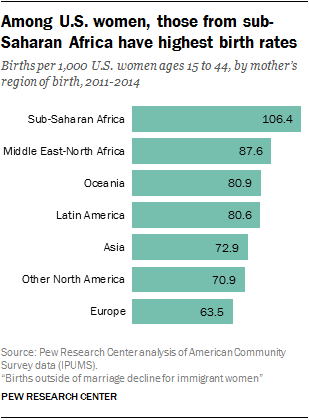 Birth rates among foreign-born women differ dramatically by region of birth. While the share of U.S. women of childbearing age from sub-Saharan Africa is quite small, this group has the highest birth rate of all – 106.4 births per 1,000 women ages 15 to 44. This is almost twice as high as the rate among U.S.-born women and implies that about 106 of every 1,000 sub-Saharan African women of childbearing age in the U.S. had a baby in the preceding 12 months. At the other end of the spectrum, the birth rate of 63.5 among women originally from Europe is the lowest of all foreign born (but still higher than the rate for U.S.-born women).20
Birth rates among foreign-born women differ dramatically by region of birth. While the share of U.S. women of childbearing age from sub-Saharan Africa is quite small, this group has the highest birth rate of all – 106.4 births per 1,000 women ages 15 to 44. This is almost twice as high as the rate among U.S.-born women and implies that about 106 of every 1,000 sub-Saharan African women of childbearing age in the U.S. had a baby in the preceding 12 months. At the other end of the spectrum, the birth rate of 63.5 among women originally from Europe is the lowest of all foreign born (but still higher than the rate for U.S.-born women).20
Foreign-born moms are older than U.S.-born moms
Since data first became available in 1970, foreign-born new mothers have consistently been older, on average, than their U.S.-born counterparts. According to census data, while 6% of all new U.S.-born mothers were teens in 2014, this share was just 2% among the foreign born. Even more striking – 18% of new U.S.-born mothers were ages 35 or older, compared with 30% of new foreign-born mothers.21
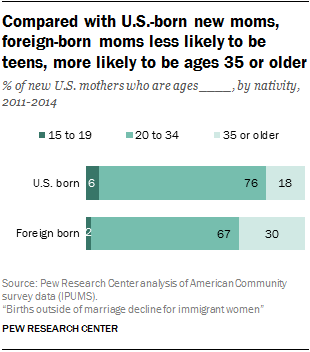 The age difference between foreign-born and U.S.-born new moms is driven, in part, by the fact that foreign-born women of childbearing age are older than their U.S.-born counterparts, and include fewer teens.22 While 18% of U.S.-born women of childbearing age are in their teens, this share is just 7% for the foreign born. And 30% of the U.S. born are ages 35 or older, compared with 44% of the foreign born. Some 51% of U.S.-born women of childbearing age are ages 20-34, versus 48% among the foreign born.
The age difference between foreign-born and U.S.-born new moms is driven, in part, by the fact that foreign-born women of childbearing age are older than their U.S.-born counterparts, and include fewer teens.22 While 18% of U.S.-born women of childbearing age are in their teens, this share is just 7% for the foreign born. And 30% of the U.S. born are ages 35 or older, compared with 44% of the foreign born. Some 51% of U.S.-born women of childbearing age are ages 20-34, versus 48% among the foreign born.
The differences in the age composition of foreign-born and U.S.-born women don’t fully explain the nativity differences in the age profiles of new mothers, however. Foreign-born women ages 35 or older are far more likely to have a baby than their U.S.-born counterparts – birth rates for this group are 50% higher for the foreign born (53.1) than the U.S. born (35.5). Fertility rates are higher for foreign-born women at all other ages, as well, though the differences are not as dramatic: The birth rate for foreign-born teens is 26.6 vs. 19.4 for U.S.-born teens; and among those ages 20-34, the birth rate is 109.4 for the foreign born and 89.1 for the U.S. born.
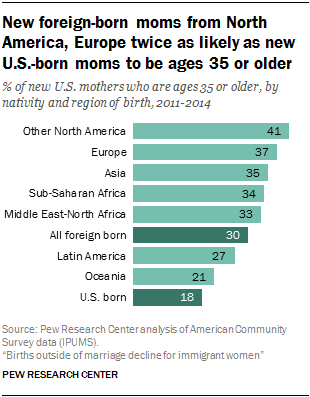 Among all foreign-born new mothers, those from Latin America are the most likely to be teens – about 4% are. This is slightly lower than the 6% share among U.S.-born mothers. Some 2% of new mothers from sub-Saharan Africa are teens, while the share is 1% or less for mothers from other regions of the world.
Among all foreign-born new mothers, those from Latin America are the most likely to be teens – about 4% are. This is slightly lower than the 6% share among U.S.-born mothers. Some 2% of new mothers from sub-Saharan Africa are teens, while the share is 1% or less for mothers from other regions of the world.
At the same time, new mothers from North America are the most likely to be 35 or older – fully 41% are. Some 37% of new mothers from Europe fall into this category. Older mothers are far less common among new immigrant moms from Oceania – just one-in-five (21%) are ages 35 or older. Among new mothers from Latin America, this share is just 27%.
Foreign-born moms far more likely than U.S.-born moms to be Hispanic or Asian
Fully 53% of foreign-born new moms are of Hispanic origin versus 15% of new U.S.-born mothers. In contrast, just 12% of immigrant new mothers are white, while whites are the dominant racial and ethnic group among U.S.-born mothers – 65%. Asians account for about one-fourth (24%) of immigrant new moms versus just 2% of the U.S. born. Some 9% of foreign-born new mothers are black, compared with 15% of U.S.-born new moms.
These patterns reflect recent shifts among both U.S.-born and foreign-born new mothers. Since 2008, the share of U.S.-born new mothers who are white dropped by about 3 percentage points, and the share who are Hispanic rose by a similar amount. At the same time, the share of foreign-born new mothers who are Hispanic dropped by about 4 points, while the share that are Asian rose by 3 points.
The racial and ethnic composition of new mothers in the U.S. largely mirrors broader population patterns. Among all U.S.-born women of childbearing age, 66% are white, 15% are black, 13% are Hispanic, and 2% are Asian. Meanwhile, foreign-born women of childbearing age are far more likely to be Hispanic (50%) or Asian (26%), than white (14%) or black (8%).
New foreign-born mothers twice as likely as U.S.-born moms to lack a high school diploma
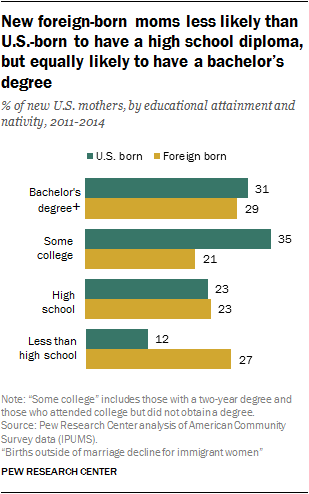 Foreign-born mothers of newborns typically have less education than their U.S.-born counterparts overall. While 12% of U.S.-born mothers lack a high school diploma, this share more than doubles to 27% among the foreign born. And while identical shares (23%) of new mothers in both groups progressed to the point of attaining a high school diploma, U.S. born moms are much more likely to have gone on to at least some college. Overall, about one-third (35%) of U.S.-born mothers have a high school diploma and some college experience (though no bachelor’s degree), a share that drops to 21% among the foreign born. When it comes to college completion, nativity differences are relatively small. Some 29% of foreign-born new mothers have earned at least a bachelor’s degree, as have 31% of U.S.-born new mothers.
Foreign-born mothers of newborns typically have less education than their U.S.-born counterparts overall. While 12% of U.S.-born mothers lack a high school diploma, this share more than doubles to 27% among the foreign born. And while identical shares (23%) of new mothers in both groups progressed to the point of attaining a high school diploma, U.S. born moms are much more likely to have gone on to at least some college. Overall, about one-third (35%) of U.S.-born mothers have a high school diploma and some college experience (though no bachelor’s degree), a share that drops to 21% among the foreign born. When it comes to college completion, nativity differences are relatively small. Some 29% of foreign-born new mothers have earned at least a bachelor’s degree, as have 31% of U.S.-born new mothers.
For the most part, nativity differences in the educational attainment of new mothers reflect the nativity differences in education among all women of childbearing age. For example, while 27% of foreign-born women ages 15 to 44 lack a high school diploma, this share drops to 18% among comparably aged U.S.-born women; and while just 23% of immigrant women of childbearing age have attained some college education, this share rises to 36% for the U.S. born.
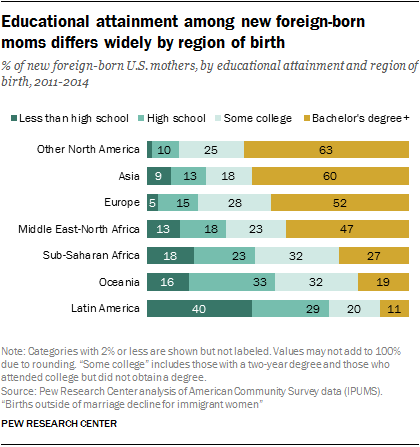 New mothers originally from Latin America have the lowest level of educational attainment of all immigrant moms. They are by far the most likely to lack a high school diploma (40%), while at the other end of the spectrum just 11% have a bachelor’s degree. Conversely, the majority of new mothers originally from North America (63%), Asia (60%) and Europe (52%) have at least a bachelor’s degree, and about 10% or less lack a high school diploma. Among new mothers from the Middle East and North Africa, almost half (47%) have a bachelor’s degree, and 13% lack a high school diploma.
New mothers originally from Latin America have the lowest level of educational attainment of all immigrant moms. They are by far the most likely to lack a high school diploma (40%), while at the other end of the spectrum just 11% have a bachelor’s degree. Conversely, the majority of new mothers originally from North America (63%), Asia (60%) and Europe (52%) have at least a bachelor’s degree, and about 10% or less lack a high school diploma. Among new mothers from the Middle East and North Africa, almost half (47%) have a bachelor’s degree, and 13% lack a high school diploma.
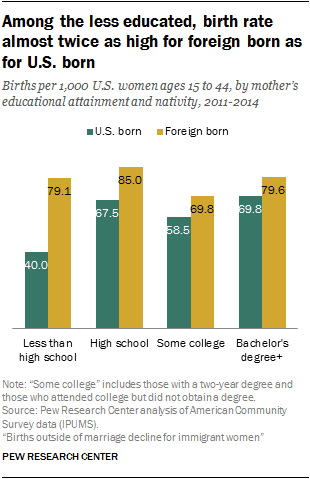 At all levels of educational attainment, birth rates are higher for immigrants than the U.S. born, and this difference is particularly pronounced among women who lack a high school diploma. While the birth rate for U.S.-born women who don’t have a diploma is 40.0 births per 1,000 women ages 15 to 44, among comparable immigrant women, the rate virtually doubles to 79.1 births per 1,000. Among U.S.-born women, those with the least education have by far the lowest fertility levels, but this pattern does not hold for immigrants. The birth rate of the least educated immigrant women is about equal to that of foreign-born women with a bachelor’s degree (79.6) and is higher than the rate for immigrant women with some college experience (69.8).
At all levels of educational attainment, birth rates are higher for immigrants than the U.S. born, and this difference is particularly pronounced among women who lack a high school diploma. While the birth rate for U.S.-born women who don’t have a diploma is 40.0 births per 1,000 women ages 15 to 44, among comparable immigrant women, the rate virtually doubles to 79.1 births per 1,000. Among U.S.-born women, those with the least education have by far the lowest fertility levels, but this pattern does not hold for immigrants. The birth rate of the least educated immigrant women is about equal to that of foreign-born women with a bachelor’s degree (79.6) and is higher than the rate for immigrant women with some college experience (69.8).
New foreign-born mothers are less financially well-off than new U.S.-born mothers
Foreign-born mothers of newborns are far more likely to have low family incomes and to be living in poverty than their U.S.-born counterparts. This may relate, in part, to the fact that foreign-born new mothers are less likely to be employed than their U.S.-born counterparts. There are striking differences in financial well-being among foreign-born new mothers. For example, those from Latin America are more than four times as likely to be living in poverty as those from North America.
Foreign-born new moms less likely to be employed, more likely to be out of the labor force than U.S.-born moms
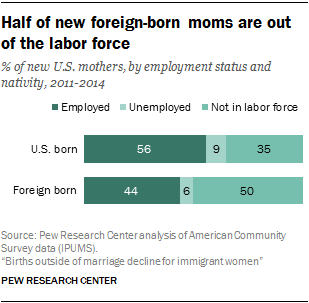 Fully 56% of U.S.-born women who gave birth in the preceding 12 months have a job, versus 44% of comparable foreign-born mothers. Most of the difference in these numbers is driven by the likelihood of being in the labor market. Fully half (50%) of new foreign-born mothers report that they are out of the labor market – meaning they are neither working nor seeking employment – versus 35% of their U.S.-born counterparts.23
Fully 56% of U.S.-born women who gave birth in the preceding 12 months have a job, versus 44% of comparable foreign-born mothers. Most of the difference in these numbers is driven by the likelihood of being in the labor market. Fully half (50%) of new foreign-born mothers report that they are out of the labor market – meaning they are neither working nor seeking employment – versus 35% of their U.S.-born counterparts.23
New mothers from the Middle East and North Africa are the least likely to be employed – just 32% are. Among new mothers from Latin America, the employment rate is 39%, and it is 44% for those originally from Oceania. At least half of mothers from Asia (51%), Europe (54%), North America (55%) and sub-Saharan Africa (56%) report that they are employed.
As with the nativity differences, much of the variation in employment by region of birth is driven by differences in labor force participation. However, there are some variations in unemployment by mother’s region of birth. It rises to 10% for those from Oceania, 9% for those from sub-Saharan Africa, and 7% for those from Latin America, while it’s about 5% or lower among mothers from other regions.
Annual incomes of new foreign-born moms from North America three times those of moms from Latin America
U.S.-born new mothers are better off financially than their foreign-born counterparts, both in terms of median family income and poverty status. The median annual family income for U.S.-born mothers of newborns is about $51,200, compared with $41,300 among foreign-born new moms. Perhaps more telling is the poverty rate for each group – while 26% of U.S.-born new mothers are living below the poverty line this share rises to 31% for foreign-born new mothers.
That being said, there is notable variation in economic well-being among new immigrant mothers, depending on where they themselves were born. Foreign-born mothers from other parts of North America boast particularly high median family incomes of almost $90,000. Those from Asia and Europe also have significantly higher incomes than their U.S.-born counterparts; about $78,000 for mothers originally from Asia, and $73,000 for those from Europe.
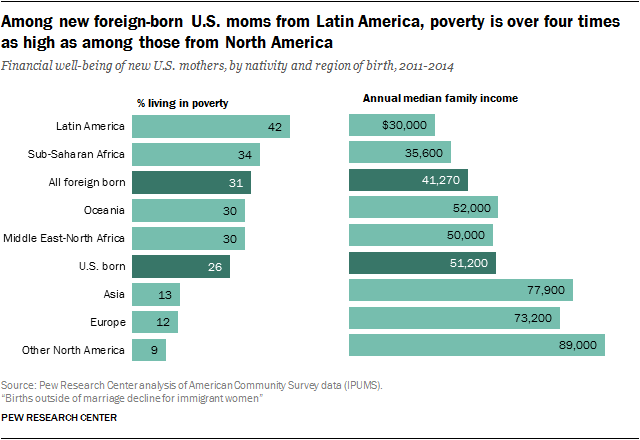
However, new mothers from sub-Saharan Africa have annual incomes of about $36,000, and those from Latin America have annual incomes of about $30,000 – about one-third of the incomes of their foreign-born counterparts from North America.
An analysis of poverty among new mothers reveals a similar pattern. Among foreign-born new mothers, the prevalence of poverty varies dramatically – just 9% of foreign-born new mothers from North America are living below the poverty line, while new mothers from Latin America and sub-Saharan Africa are about four times as likely to be living in poverty (42% and 34% are, respectively).
Half of new foreign-born mothers have been in the U.S. for more than a decade
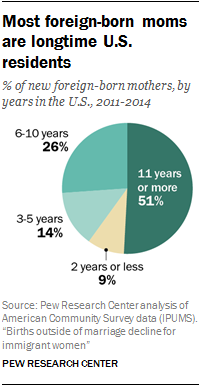 The vast majority of new foreign-born mothers have lived in the U.S. for many years. About three-quarters (77%) of these women have been in the U.S. for six years or more, and fully half (51%) have been in the U.S. for 11 years or more. Some 14% of new foreign-born mothers have been in the U.S. for three to five years, and 9% immigrated within the preceding two years.
The vast majority of new foreign-born mothers have lived in the U.S. for many years. About three-quarters (77%) of these women have been in the U.S. for six years or more, and fully half (51%) have been in the U.S. for 11 years or more. Some 14% of new foreign-born mothers have been in the U.S. for three to five years, and 9% immigrated within the preceding two years.
To some extent, this pattern reflects the characteristics of all foreign-born women of childbearing age. The majority (60%) have been in the U.S. for 11 or more years, while a much smaller share (9%) are recent arrivals within the preceding two years. Some 10% of foreign-born women of childbearing age have been in the U.S. for three to five years, as have 20% of those who have been in the U.S. for six to 10 years.
Fertility rates are particularly high for foreign-born women who have been in the U.S. for at least three years, but fewer than 11 years.[24. This jibes with research on Hispanic immigrants that indicates their fertility rates typically peak about five years after arrival.] Among women ages 15 to 44 who have been in the U.S. for three to five years, the birth rate is 106.5 births per 1,000, and among those women who have been in the U.S. for six to 10 years it is 100.1 births per 1,000. The birth rate for women who were in the U.S. for two years or less is relatively low – 76.2 births per 1,000. Immigrants who have been in the U.S. for 11 years or more have an even lower birth rate (66.5), which may be due in part to the fact that these women are less likely than more recent immigrants to be in the prime childbearing ages of 20 to 34 years. While 40% of long-term immigrant women are in this age range, 61% of more recent immigrant women are.
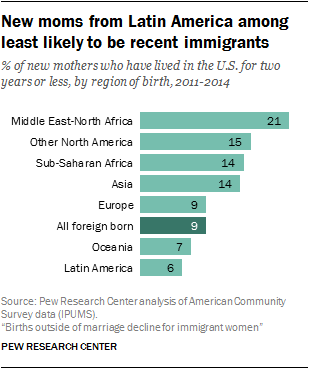 The share of births to recent immigrants varies depending on which region of the world the mom hails from originally. Among mothers originally from Latin America, just 6% arrived within the previous two years, while 56% had been living in the U.S. for 11 years or more. The shares of new mothers from Oceania or Europe who are recent immigrants are also quite low – 7% and 9%, respectively.
The share of births to recent immigrants varies depending on which region of the world the mom hails from originally. Among mothers originally from Latin America, just 6% arrived within the previous two years, while 56% had been living in the U.S. for 11 years or more. The shares of new mothers from Oceania or Europe who are recent immigrants are also quite low – 7% and 9%, respectively.
New mothers from the Middle East and North Africa are far more likely to be recent arrivals – 21% arrived in the U.S. within two years prior to the survey.
Seven-in-ten new foreign-born moms speak English well
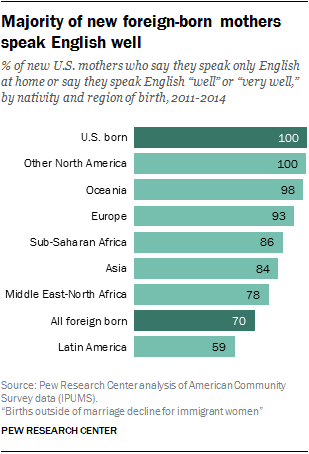 Some 70% of new foreign-born mothers either speak only English in the home or say that they speak English very well or well. Not surprisingly, those foreign-born new mothers who hail from predominantly English-speaking regions of the world – North America and Oceania – boast almost universal English proficiency. Even among new mothers originally from Europe, more than nine-in-ten speak English at least well. The share of moms of newborns who speak English well is considerably lower for those from Latin America, though the majority – 59% – report that they do.
Some 70% of new foreign-born mothers either speak only English in the home or say that they speak English very well or well. Not surprisingly, those foreign-born new mothers who hail from predominantly English-speaking regions of the world – North America and Oceania – boast almost universal English proficiency. Even among new mothers originally from Europe, more than nine-in-ten speak English at least well. The share of moms of newborns who speak English well is considerably lower for those from Latin America, though the majority – 59% – report that they do.
While most foreign-born new mothers are able to communicate at least well in English, many of those who cannot are living in what some researchers term “linguistically isolated” households in which no person ages 14 or older speaks English at least “very well,” or speaks English at home all the time. All told, 30% of foreign-born mothers are living in this type of arrangement, which is particularly common among moms of newborns from Latin America (37%). Among new mothers from the Middle East and North Africa, 28% are in linguistically isolated households, as are 22% of those from Asia and 21% of those from sub-Saharan Africa. Rates of linguistic isolation are far lower for new moms from other regions – 13% for those from Europe; 10% for those from Oceania; and 1% for those from the remainder of North America.


